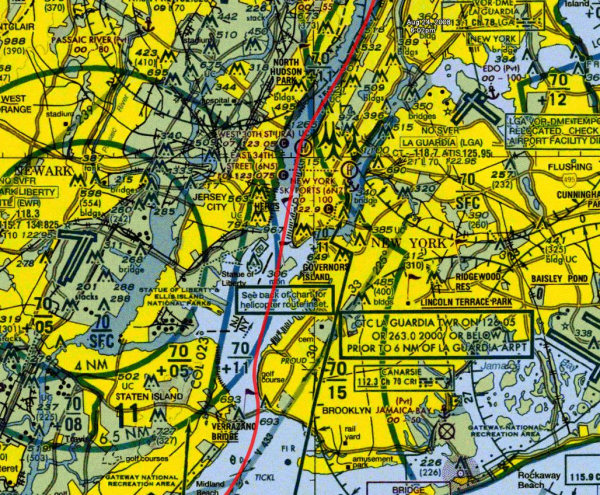| Date | Aircraft | Route of Flight | Time (hrs) | Total (hrs) |
| 18 Aug 2008 | N21481 | SMQ (Somerville, NJ) - Hudson River VFR Corridor - SMQ | 1.1 | 646.8 |
June 2004, New York, NY: I stood on the deck of the Intrepid moored in the Hudson River. Above the World War II aircraft carrier, a steady stream of fixed and rotary wing aircraft passed back and forth along the river at relatively low altitude. This was my first exposure to the Hudson River VFR Corridor; a virtual tunnel bored directly through the complex superposition of Class Bravo (i.e. really busy) airspaces surrounding Newark, La Guardia, and JFK. The corridor provides free passage to aircraft transiting the busy New York City terminal area without forcing them to contact air traffic control. After all, those controllers are busy juggling heavies queued up for the limited runway real estate available in the New York City area. As I watched the light aircraft flying along the river, I envied them their magnificent view of the city and hoped that someday I might have an opportunity to fly the corridor.
August 17, 2008: Kristy, the Bear and I took wing to visit our friends Brent and Jackie in New Jersey. Warrior 481 spent the night at Somerset Airport (SMQ), a bustling general aviation airport west of Newark that became the 80th airport I landed at as pilot in command. Being so close to New York City, it struck me as an excellent home base for an excursion down the Hudson River Corridor.
There is a lot of information available concerning the corridor and I won't bother trying to repeat it here. The basic rules are simple. Aircraft self-announce their positions on the designated frequency as though flying into a non-towered airport. While the ceiling of the corridor is an imaginary deck at 1100 feet, the floor and walls are defined by the river itself.
This is what the corridor looks like on the New York Terminal Area Chart. Within the morass of overlapping airspace, the corridor is visible as regions with a floor of 1100 feet that VFR pilots must remain below unless specifically cleared into the Class Bravo space overhead. The red trace represents my actual flight path through the corridor as logged by my GPS and superimposed using Google Earth.
I wanted to make the trip in the early evening, when the setting sun would provide ideal lighting of the skyline for photographs. But the Yankees had a game scheduled that afternoon, thus creating a temporary flight restriction on the northern end of the corridor. And who wants to mess around with one of those?
This is how I found myself departing Somerset airport on Monday morning at 9:00. Being the only one in my family who can swim, I made an executive decision to fly alone. My route took me southeast below Newark's Bravo airspace, across Raritan Bay, and over the Verrazano Narrows Bridge that links Staten Island to Brooklyn. Once in the corridor, I continued north past Manhattan to the Tappan Zee Bridge before returning to Somerset. I took a few pictures along the way, but was rather busy keeping track of my position and altitude lest I wander into Bravo airspace without permission or, worse, into another aircraft; Manhattan is surrounded by a nimbus of helicopters that circle the city like gnats.
Over Raritan Bay, approaching the Hudson River Corridor via the Verrazano Narrows Bridge. Manhattan is visible in the distance with only the tallest buildings poking up above the haze. The ceiling of the Hudson River Corridor is 1100' above sea level and I maintained 900' for the entire trip.
The Hudson River Corridor operates much like a road - opposite traffic keeps to the right. My northbound track meant that I was on the wrong side of the corridor to get close to the Statue of Liberty. But it was amazing to see her highlighted by the rising sun.
Ellis Island, just north of the Statue of Liberty.
Lower Manhattan. The lighting made me wish that I had been able to make this flight in the evening, but it was nevertheless an awesome sight.
From street level, it seems as though the concrete and steel canyons of New York City must go on forever. Strangely enough, from 900' over the Hudson River, I was overcome by the same impression. This is a huge city.
The Goldman Sachs Tower in Jersey City on the west side of the Hudson River.
Beyond Lower Manhattan, the buildings dwindle in stature somewhat until Midtown, which is dominated by the Empire State Building.
Midtown Manhattan, silhouetted in the morning haze.
A new building reaches for the heavens.
Abeam the Empire State Building. No giant apes in sight today.
Before I knew it, I had reached the George Washington Bridge. The mightiest of New York City's skyscrapers were behind me.
The Tappan Zee Bridge marked the end of my northward trek along the Hudson. Beyond the bridge, I climbed to 2500' and turned west toward Somerset. When I returned to Brent and Jackie's house, Kristy met me at the door to ask how it went. "Amazing" was the only thing I could think of to say. And like flying through the Rocky Mountains, the photographs are interesting enough, but cannot convey a real sense of the experience.
This image was generated by exporting data from my Airmap 500 GPS into Google Earth. The blue trace shows my actual ground track through the southern portion of the Hudson River Corridor. Isn't technology great? In this case, the GPS was more of a spectator than anything else. I relied on the river and my altimeter to keep myself out of trouble.

























